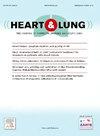Using lightweight convolutional neural network to identify ventilation/perfusion scintigraphy for acute pulmonary embolism
IF 2.6
4区 医学
Q2 CARDIAC & CARDIOVASCULAR SYSTEMS
引用次数: 0
Abstract
Background
Quantifying ventilation/perfusion (V/Q) scintigraphy and reducing errors caused by subjective interpretation of approximate grayscale images are clinically and analytically challenging.
Objectives
This study aims to objectively quantify V/Q results by developing a novel convolutional neural network architecture.
Methods
In this retrospective study, we collected data from patients with acute pulmonary embolism (PE). We proposed PENet, a lightweight neural network architecture based on depthwise separable convolution for identifying defect areas in V/Q scans. The defect area percentage (DA%) was obtained through threshold setting to quantify the mismatch range. The significance and accuracy of our model were verified by combining clinical data. We collected 4608 original scans from 288 patients as the preliminary dataset. We set the pixel threshold value to 30.
Results
PENet demonstrated accuracy (87.47 %), precision (89.22 %), and F1-score (91.01 %), superior to those of classical and other lightweight models. Spearman’s rank correlation coefficient revealed correlations between DA%max and N-terminal pro-brain natriuretic peptide, DA%min and age, average DA% and age, average DA% and troponin I, DA%sum and age, and DA%sum and predicted percentage of diffusing lung capacity for carbon monoxide (P < .05). DA%max (P = .004), DA%sum (P = .004), and average DA% (P = .006) differed significantly among PE risk groups. With the assistance of PENet, junior radiologists could achieve a high degree of consistency with senior radiologists (kappa=0.832, P < .001).
Conclusions
The accuracy of PENet reached 87.47 %. DA% calculated automatically could reflect PE severity and correlate well with clinical data. PENet shows promising results for clinical use.
应用轻量级卷积神经网络识别急性肺栓塞的通气/灌注显像
量化通气/灌注(V/Q)闪烁成像和减少由近似灰度图像的主观解释引起的误差在临床和分析上具有挑战性。本研究旨在通过开发一种新颖的卷积神经网络架构,客观地量化V/Q结果。方法回顾性分析急性肺栓塞(PE)患者的临床资料。我们提出了一种基于深度可分离卷积的轻量级神经网络体系结构PENet,用于识别V/Q扫描中的缺陷区域。缺陷面积百分比(DA%)通过阈值设置获得,以量化不匹配范围。结合临床资料验证了模型的意义和准确性。我们从288名患者中收集了4608份原始扫描作为初步数据集。我们将像素阈值设置为30。结果spenet的准确率(87.47%)、精密度(89.22%)和f1评分(91.01%)均优于经典模型和其他轻量级模型。Spearman等级相关系数显示DA%max与n端脑利钠肽前体、DA%min与年龄、平均DA%与年龄、平均DA%与肌钙蛋白I、DA%sum与年龄、DA%sum与一氧化碳弥散肺活量预测百分比之间存在相关性(P <;. 05)。PE危险组间DA%max (P = 0.004)、DA%sum (P = 0.004)、平均DA% (P = 0.006)差异有统计学意义。在PENet的辅助下,初级放射科医师与高级放射科医师的一致性较高(kappa=0.832, P <;措施)。结论PENet的准确率可达87.47%。自动计算的DA%能反映PE的严重程度,与临床数据有较好的相关性。PENet在临床应用中显示出良好的效果。
本文章由计算机程序翻译,如有差异,请以英文原文为准。
求助全文
约1分钟内获得全文
求助全文
来源期刊

Heart & Lung
医学-呼吸系统
CiteScore
4.60
自引率
3.60%
发文量
184
审稿时长
35 days
期刊介绍:
Heart & Lung: The Journal of Cardiopulmonary and Acute Care, the official publication of The American Association of Heart Failure Nurses, presents original, peer-reviewed articles on techniques, advances, investigations, and observations related to the care of patients with acute and critical illness and patients with chronic cardiac or pulmonary disorders.
The Journal''s acute care articles focus on the care of hospitalized patients, including those in the critical and acute care settings. Because most patients who are hospitalized in acute and critical care settings have chronic conditions, we are also interested in the chronically critically ill, the care of patients with chronic cardiopulmonary disorders, their rehabilitation, and disease prevention. The Journal''s heart failure articles focus on all aspects of the care of patients with this condition. Manuscripts that are relevant to populations across the human lifespan are welcome.
 求助内容:
求助内容: 应助结果提醒方式:
应助结果提醒方式:


